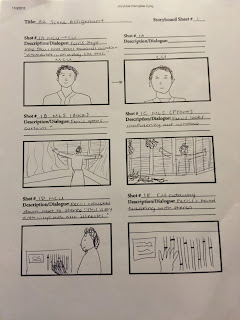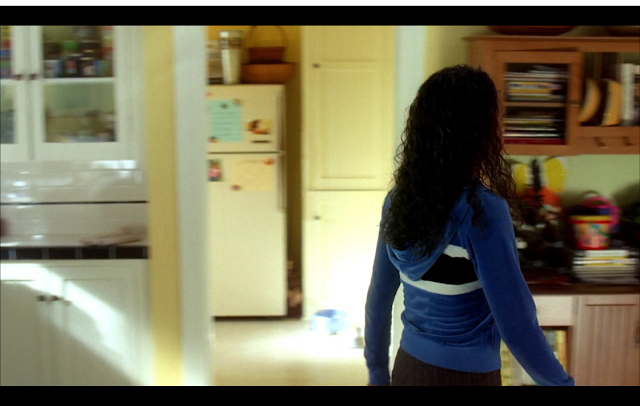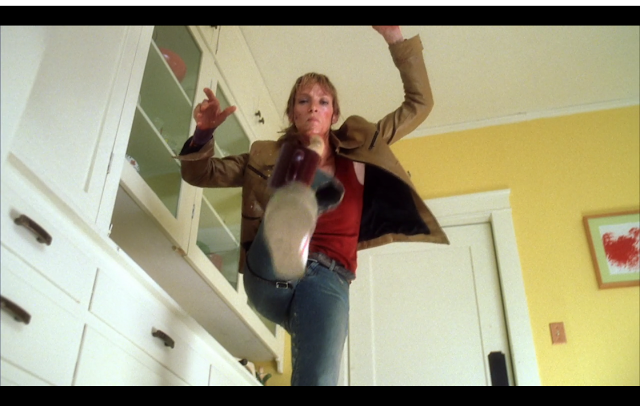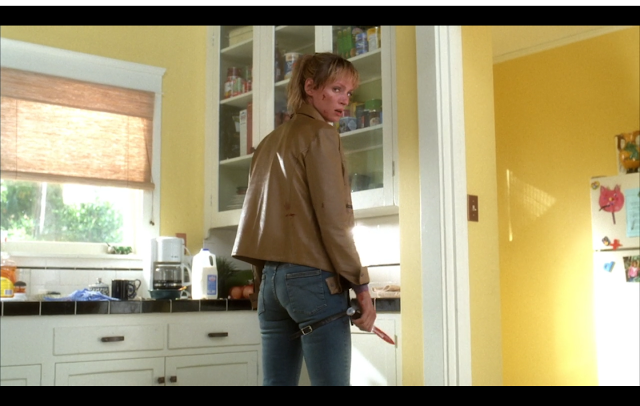"Kill Bill: Vol. 1"
This scene starts with a God’s eye view of Vernita’s kitchen, with Vernita placed on the far right making coffee and the Bride making her way from the door into the dining room. This shot to me symbolizes the start of something important about to happen. As this shot is taking place, the Bride’s voice-over is explaining to the audience who this character is that she is fighting with, while also giving a backstory to Vernita’s character. We learn that Vernita used to be in the same line of work as the Bride. The wall in the center of the frame separate the two characters who are trying to remain distant from each other. They both know how dangerous the other one is. As this shot cuts into the next shot, the Bride asks for a towel and Vernita grabs one and throws it to the Bride.

As Vernita throws the towel to the Bride, the distance between them is evident. The counter is placed between them already creating distance, but even their actions show distance; the Bride doesn’t move her feet to pick up the towel, she just leans over to grab it.
In this shot, Vernita says, “So I suppose it’s a little late for an apology, huh?”. Her body isn’t facing the camera and her face is facing down. Her body doesn’t really match what she is saying to the Bride, or at least what she is trying to portray, that being sorry for ruining her life. This meaning that she most likely doesn’t mean that she is sorry, she’s more sorry for herself because she now knows she’s in trouble.
As the Bride is still tending to her wounds she says, “You suppose correctly”. Solidifying the fact that she is there to kill Vernita. She is still placed behind the counter, still trying to keep distance from Vernita, trying to keep the conversation calm, for the time being.
In this shot, Vernita reacts to the Bride’s response in a very vulnerable manner; the composition of the shot aids this reaction. The camera is placed behind the Bride so you can still see her actions, which looks like she isn’t caring at all what Vernita is saying. Vernita, small in the frame, is getting in the Bride’s face and about not causing trouble in front of her daughter while also taking a defensive stance on the other side of the counter. Her daughter causes her to be in a vulnerable state which is emphasised by the higher camera angle to make Vernita look smaller than the Bride in the frame.
This shot is pretty similar but also pretty different from the shot before this. Now they are equal height in the frame and the distance between them is greater, but because the focus is mainly on the Bride, this shows that she is not worried about Vernita being a threat. She still holds the higher ground in this situation, even though she is in Vernita’s territory.
Vernita looks a little relieved by the Bride saying she won’t murder her in front of her daughter, backs off of the Bride and breaks the defensive position she was just standing in.
As the Bride walks up to the counter to make herself comfortable, she continues to try and intimidate Vernita by saying, “It’s mercy, compassion, and forgiveness I lack, not rationality”.
It seems like this technique works, because Vernita gives the Bride a look of slight fear and makes her way back into the corner of the kitchen, where she can be far away from the Bride.
The Bride watches as Vernita takes her place in the corner, her eyes never leaving Vernita, and she stands confidently at the counter.
At this point Vernita feels a little defeated, she is now at a point where she is admitting to the bad thing she did and almost begging (subtly) for her life. She is literally and figuratively backed into a corner.
The Bride, clearly not phased by the situation and casually leaning on the counter, isn’t playing into her game. She tells Vernita that if they were to be “even”, she would have to go up into her daughters room and kill her.
Vernita shifts her stance and her eyes widen when the Bride says this about her daughter. She is feeling threatened.
In these last 5 shots, the framing has positioned both characters in the frame alone, which adds to the fact that Vernita is definitely trying to keep her distance from the Bride at this point in the scene.
Vernita now moves up to the counter getting back into her defensive mode. She again tries to subtly beg for forgiveness by trying to convince the Bride that she is a better person now. She is now smaller than the Bride in the frame again, showing that she does not have the power at this moment in the situation.
The distance between the characters has now gotten smaller, the conversation is getting more heated and the characters are going on the defensive.
The camera pans with Vernita as she walks over the bulletin board to grab a picture of her daughter to help her plea for forgiveness.
The Bride still isn’t buying it and tells her to stop what she’s doing. She is still confident in her stance and doesn’t move a muscle while Vernita begs.
The Bride’s response to Vernita’s play shocks Vernita as she moves the picture out of frame and begins to look extremely defeated. She is still very small compared to the Bride in the frame adding to her being defeated.
Once again, the Bride doesn’t move as she explains to Vernita that “parading” her daughter in front of her will not gain the Bride’s sympathy.
In this shot, Vernita shifts back into her defensive stance, with both her hands on the counter and her eyes locked on the Bride.
The Bride also takes a defensive stance as she tells Vernita that they have some unfinished business to take care of.
We are then taken to a profile, two-shot of the Bride and Vernita facing off at the counter. They are negotiating the time and place that the Bride will kill Vernita. At this point, they are equal opponents now, as they negotiate a plan to meet at night and have a fair knife fight. At the end of this shot Vernita makes a sudden movement, explaining that she is going to prepare her daughter some cereal, that makes the Bride jump back slightly.
This shot coming after the sudden movement of Vernita shows the Bride backing up to the wall. The cereal is shifting the tone of the situation.
Vernita now feels out of the clear because she has her back facing the Bride. If she thought she was still in danger, she definitely wouldn’t have her back towards the Bride. She is relaxed a little bit.
Honestly, I still haven’t figured out what is so significant about this shot. I’ve been trying to figure it out for a while now and still haven’t been able to come up with an answer. But for some reason, I really love this shot! It’s very simple, but somehow it adds tension to the scene.
The Bride is backed up to the wall, she is trying to keep the space between them and starting to relax now that they have negotiated to meet later that night.
Vernita, still feeling comfortable and relaxed, walks away from the counter and walks into another room with her back facing the Bride.
The Bride keeps her eyes locked on Vernita’s every move as she exits the room. She is placed on the right side of the frame, in between the archway and the counter, making her feel sort of trapped.
Vernita makes her way, confidently, back to the counter with the cereal box in sight.
The Bride is still placed in the frame to make her feel trapped, this change in frame is now making it seem like tone in the scene is about to change.
Vernita, again with her back facing the Bride, is now getting locked and loaded.
The Bride thinks she is in a safe-zone but the frame is still trapping her on the right.
Vernita surprises the Bride by firing a shot at her from inside the cereal box.
The Bride is surprised by this shot, but it misses her and hits the wall the the right of her.
The Bride quickly reacts by drop kicking her coffee mug at Vernita’s head.This shot is filmed in slo-mo and at a low angle, showing her technique and calmness to the situation. She is a natural and clearly superior in this situation depicted by this low angle shot.
The mug flies past Vernita’s head and crashes into the wall behind her just like the bullet had done to the Bride.
We get a CU of the Bride pulling her knife out of its holster. This is HER weapon, and the clearly knows how to use it.
This shot follows the knife from the Bride’s hand to Vernita’s chest and follows until she falls to the ground, showing the speed and impact of her death.
This shot follows the Bride from her knife throwing stance to her looking down on Vernita’s dying face. This is shot at a low angle, showing the Bride’s power in this moment. She moves slowly towards Vernita and also moves slightly higher in the frame as she positions herself over Vernita’s face and stares down at her in victory.
We then get a CU on Vernita as she looks at the Bride one last time and her head falls to the floor as she takes her final breath. She is dead, and it happened so fast.
The Bride’s face slightly changes from victorious to a sense of dissatisfaction. This isn’t how she wanted it to happen.
We are taken to another God’s eye view of the kitchen, instead this time it is just the kitchen side. We see the mess on the ground from the cereal and the lifeless body of Vernita Green. The camera isn’t perfectly framing the kitchen, it is slightly slanted, creating a look of disorder, to emphasize the chaos that has just ensued in a suburban home.
This shot is one of my favorites, we start out looking up at the Bride taking her knife out of Vernita’s chest, as she stands up, she reveals the daughter standing in the archway behind the Bride, looking at her moms’ lifeless body on the kitchen floor. The area in which she in standing places her right underneath the Bride’s knife, which is covered in blood.
The Bride turns around and notices Vernita’s daughter.
We get a high angle of Vernita’s daughter, showing how powerless she is in this moment.
We return back to the shot of the Bride staring at Vernita’s daughter, still no dialogue between the two characters has started.
We are then thrown back into a low angle shot of Vernita’s daughter looking at the Bride with Vernita’s body in the foreground. This reminding us of the severity of the situation. A daughter has just witnessed her mother’s murder and has no idea what to do.
Back to the medium low angle shot of the Bride standing over Vernita’s body. She grabs a towel and begins to wipe the blood off of her knife as she explains to Vernita’s daughter that she didn’t want to kill her mom in front of her.
Back to the high angle shot of Vernita’s daughter. Blood is splattered on the wall next to her as she stands there motionless, still in shock, and listens to the Bride.
The Bride, with her back towards the child, she tries to keep her composure. She is uncomfortable with the fact that she has just killed the girls’ mother in front of her and can’t look her in the eyes as she cleans the weapon she used to kill her.
This shot of the Bride putting the knife back into it’s holster is also one of my favorite shots from this move. The way she glides the knife on the leather, to feel her way back into the holster safely, shows her knowledge of the weapon and her confidence in using it.
The Bride turns around to finally face Vernita’s daughter.
She still doesn’t know what to do and still hasn’t moved from the archway.
The Bride tells Vernita’s daughter that if she is still upset about her mom’s death in the future, she will be waiting for her to make her vengeance.
We end this scene with a shot of Vernita’s daughter’s feet standing in the cereal as we watch the Bride walk out of frame. Vernita’s daughter is being abandoned in a situation she has no idea how to handle.






































































































